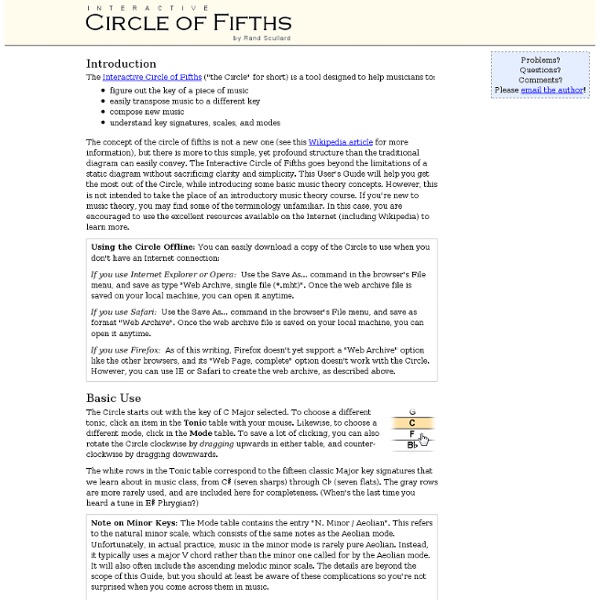Interactive Circle of Fifths User's Guide

Key Chords
Key Chords app generates guitar chord progressions automatically. Use it free online, or get the app for Mac, Windows or iOS (iPad) - Click on a chord to preview how it sounds. - Drag and drop to arrange the chord progression - Tweak the settings to control the playback speed Or role the dice and Key Chords will automatically generate a nice sounding progression. Select a Key: Select a key and choose a the major or minor scale. The resulting chord chart will display applicable chords for the selected key. Click a chord: ... and you will hear a cheap computer generated guitar playing the chord. Drag & Drop: - Chords from the chart into the progression timeline. - Rearrange Chords in the progression. - Remove chords from the progression. Roll the Dice: ... and a random chord progression will appear in the timeline. The numbers below each chord in the progression refer to the number of "beats" the chord will linger for. The "Rake Speed" refers to the speed of a single "strum." The main chart areas.
A Jazz Improvisation Primer
This is the online version of my text, A Jazz Improvisation Primer. Here you can find information on almost every topic relating to jazz improvisation, from jazz history to music theory to practical advice on playing in a group. A German translation, by Edgar Lins, is online, at There is also a Hungarian translation at provided by Makrai Balázs. A Portuguese translation by Cláudio Brandt can be found at And now there is a French version at A Jazz Improvisation Primer is brought to you by Outside Shore Music. By the way, this work has been online since 1992, so if parts of it seem a bit dated, that’s why. Contents Appendices Thanks To: Ed Price (edp@panix.com), for the conversion of this resource into hypertext!
Load Up Your iPad with a Massive Library of Over 38,000 Free eBooks
The iPad is a great device to read on, and if your digital library is feeling a little bare then you’ve come to the right place. We’ve found some of the best places to get free ebooks, ready to be downloaded and opened with iBooks on your shiny new iPad (or iPhone, iPod, Kindle, Nook, or Android, for that matter). Project Gutenberg Top 100 – Full of classics, if you’re only going to visit one source for free ebooks, Gutenberg should be it. They have over 38,000 free ebooks available, and their top 100 list is basically a mirror of the Western Canon of literature. Grab titles from the popular lists, and then search category or by your favorite author to load up on a nearly infinite amount of reading. Audiobooks are offered in some cases too.Gutenberg Bookshelf by Category – Looking for books on a specific topic? Gutenberg is probably the best source online, but other sites offer free ebooks too: Know any other quality sources for free ebooks?
Paleo Recipe Book | Over 370 easy Paleo recipes
© 2015 Paleo Leap, LLC. All rights reserved. 15 extra Paleo desserts. We like our sweets too you know! Make your food tasty and interesting with clever use of herbs and spices. ClickBank is the retailer of products on this site. Wondering where time went? Use one of our extra 30 quick & simple recipes to prepare dinner in zero time! 4 of our exclusive cheat sheets to make your life simple: Troubleshooting Paleo, coconut milk, Paleo flours & thickeners, portion sizes. Having a plan is key! Our Meal Plan lets you jump on board right away with everything on autopilot and planned out for you.
Related:
Related:



